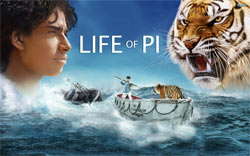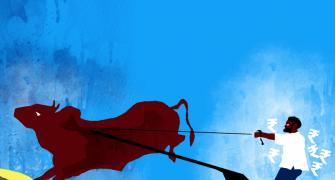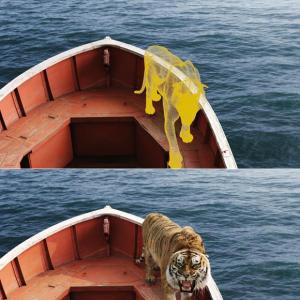 There are remarkable similarities between Bombay Jayashri's Oscar-nominated song in Life of Pi and Irayimman Thampi's age-old composition. We make a case for the 200-year-old melody.
There are remarkable similarities between Bombay Jayashri's Oscar-nominated song in Life of Pi and Irayimman Thampi's age-old composition. We make a case for the 200-year-old melody.
Almost every Keralite, including Tamil and other language speaking ones, would have been put to bed in their childhood listening to the strains of Omana Thinkal Kidavo, a lullaby composed 200 years back in April 1813 by Irayimman Thampi (rhymes with alphabet "p"), on the occasion of the birth of his nephew, Swathi Thirunal, who was called Garbhashriman, or one who was anointed king when he was in his mother's womb.
It was thus a lullaby composed for a king.
Swathi Thirunal, in his brief life of 33 years, went on to become one of the greatest administrators whose far-reaching reforms are one of the prime reasons why Kerala had a historical lead in almost every social indicator.
He was also a great patron of the arts and established himself as a great composer in different languages and is revered on the same footing as the great trinity of Carnatic music. Thampi himself has several well-known classical music and kathakali compositions to his credit, including probably the best known Malayalam songs which evoke the rasas of bhakti, shringara and vatsalya.
The lullaby seems to have now woken up every Keralite, as the descendants of Thampi have alleged that the opening song in Ang Lee's latest film, Life of Pi, is a copy of the early 19th century piece. The controversy got further enhanced as the song won two nominations for this year's Oscar Awards, including for "original song", the emphasis being on "original".
The two pieces can be compared at two levels. The first relates to the style of composition. Thampi's string of 25 couplets is all in the form of questions comparing the baby with some of the most endearing ideas and things in life, both animate and inanimate. These could be read as questions posed to oneself or to the child. This style used in composing a lullaby is the hallmark of Thampi's work and is unique to Malayalam, and perhaps to any other language. The same style is adopted in six of the eight lines in Bombay Jayashri's piece, and provides a strong undercurrent to the current controversy as it makes the other similarities stand out in relief.
The second relates to the content of the two lullabies. At least four of the six lines in Jayashri's piece bear close resemblances with that of Thampi:
1. Jayashri: Mayilo, thogai mayilo (Are you a peacock? Or its plumage?)
Thampi: Chanchadiyadum Mayilo (Are you the hopping and dancing peacock?)
2. Jayashri: Kuyilo, koovum kuyilo (Are you a cuckoo bird? A cooing cuckoo?)
Thampi: Mrudu panchamam padum kuyilo (Are you the cuckoo which sings the soft panchamam?)
3. Jayashri: Nilavo, Nilavin oliyo (Are you the moon? Or the moonlight?)
Thampi: Omanathinkal kidavo … Paripoornendu thante nilavo (Are you the beautiful moon? ... Are you the light of the full moon?)
4. Jayashri: Malaro, malarin amudho (Are you a flower? Or the nectar in the flower?)
Thampi: Nalla komala thamara poovo, poovil niranja madhuvo (Are you the good tender lotus flower? Or the nectar filled in the flower?)
The two remaining lines are a mere extension of the basic ideas of Thampi to eyelids and fruit. What is left are the opening lines, including Kanne Kanmaniye which resembles another piece, Kanne Navamaniye, sung by Jayashri herself for an album referred to below.
Some have argued, in comments on the net that the words kuyil, mayil, moon, flower, etc have been around for ages and nobody has exclusive rights to the same. But, the crux of the controversy is not about the mere use of these words, but the fact that more than half of Jayashri's work consists of words and phrases, which owe a debt, in their meaning and usage, metaphor, context, style, and even sequence (barring one or two interchanges),
If one were to go by the "no exclusive right" argument, someone could compose a song starting "Vande mataram…" and claim originality through improvisation (another argument on the net, not claimed by Jayashri herself), as the country has been revered as Mother from time immemorial. This is as preposterous as composing a slight variation of "Twinkle twinkle little star…" and claiming "originality" as both "stars" and "twinkling" have been around for ages.
One resemblance could be an accident. Two, a coincidence. A third and fourth similarity with another work, and that too in an eight-line song, definitely raises eyebrows, especially when the composition follows the unique style of Thampi. Was Jayashri unaware of the earlier composition by Thampi? In her interviews to national dailies, she gives no clue of having been familiar. When the issue was raised, she was evasive, forget about owning up a debt to Thampi's work. On the other hand, she states that words such as kuyil and mayil are there even in Sangam literature to describe love and affection, and that she heard these words and usages from her mother and grandmother. Apparently, her family has roots in Vandazhi, a village near Palakkad in Kerala, where she used to spend her vacations as a schoolgirl. She asks: "Why would I take something from Irayimman Thampi's work?"
What Jayashri does not disclose is that she herself had rendered an almost complete 14-minute version of Thampi's work (usually only the first few and other select couplets are sung) for a collection of seven Indian lullabies, titled "Vatsalyam" (2001). She sings it in Raag Desh as against the popular Nilambari, Navroj, or the original Kurinji ragas. She also does not reveal how the makers of the film got in touch with her, barring stating that they had heard her voice "somewhere". It would not be surprising if this collection of lullabies was what led them to her.
The Random House Dictionary defines plagiarism as the "use or close imitation of the language and thoughts of another author and the representation of them as one's own original work". The Oxford English Dictionary defines it as "the wrongful appropriation or purloining and publication as one's own, of the ideas, or the expression of the ideas… of another". Even after allowing for the universality of the emotions underlying a lullaby, going by the above comparison and the use of the style of questions, there is definitely an imitation of the language, thoughts, ideas and expressions of Thampi, and these have been represented to be as that of Jayashri. Add to this her earlier familiarity with Thampi's work, and the circumstances that could have led to her being identified for the film, and the case is complete.
But then, plagiarism is neither a crime nor a civil offence, especially when the original piece is not covered by the Copyright Act. So, where does that leave legions of Thampi admirers worldwide? The minimum they would expect is an acknowledgement both by Jayashri and others involved in making the film that the song was based on (and not just inspired by) the work of Thampi, and due credits to this effect in the titles of the film.
In the meantime, they could take comfort, firstly, from the fact that of all the lullabies in the collection referred to above, including those by Thyagaraja, Vadiraja Swami, Surdas, Kulashekara Azhwar, and folk and Bengali songs, the source for the song in Life of Pi was the one by Thampi! Secondly, they should be delighted that Thampi's ideas and style have won international acclaim, though indirectly, and a couple of centuries late. In the bicentennial year of the celebrated lullaby, they can now listen again to its enchanting lines that they grew up listening to, and slip into slumber, peacefully, and with pride!










